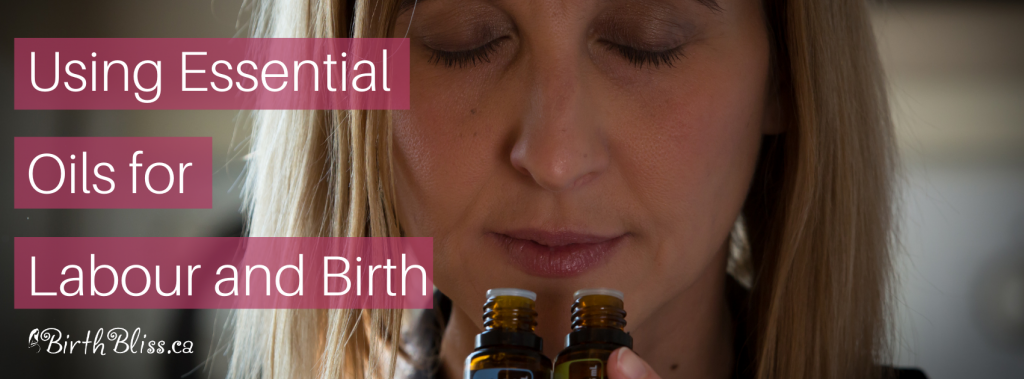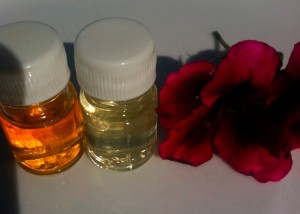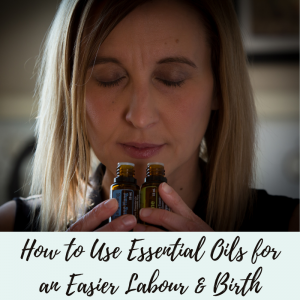
Using essential oils during your labour can be a wonderful way to support what your body is doing in a gentle and holistic way. If you are new to the idea of essential oils, please read my earlier post about why using essential oils is safe and beneficial.
During birth there is truly a lot going on at every level: physically, emotionally, mentally and even spiritually. The thing I love about essential oils is that they help at all these levels and really give the body, the mind and the spirit tools to help regain balance.
There are two main ways to use essential oils in labour: aromatically and topically. Essential oils can be diffused with a diffuser or you can simply put a drop on your hands, cup them over your nose and inhale. Essential oils are registered in the olfactory bulb in the brain (the part that interprets smells). The olfactory bulb is deeply connected to the limbic system, which current science understands to be the part of the brain primarily responsible for our emotional life. It also has a great deal to do with the formation of memories. This is why a smell can instant transport you back to Grandma’s kitchen and all the warm fussy feelings, which that place and memory invoke.
Certain essential oils trigger specific emotional responses. It may seem hard to believe if you haven’t experience it, but just smelling an essential oil can alter your mood. It’s really quite incredible how quickly it can affect the way you feel emotionally.
The most familiar and probably well known example is Lavender. Lavender has a very calming and soothing aroma. Diffusing lavender is a great way to reduce stress by calming the nervous system and can bring a real spirit of gentleness into the delivery or birth room. Diffusing an essential oil in the labour room has the added advantage of covering up any unpleasant hospital smells.
In recent years there have been a number of very encouraging studies with lavender essential oil and labour. The latest study (published Nov 2016) investigated the effect of lavender inhalation on the severity of labor pain and the duration of labour. Women in the lavender group inhaled a 10% lavender essential oil dilution applied to the palms of their hand, and inhaled for three minutes at three different stages of labour. These women experienced a significant drop in their pain levels; from 9.6 out of ten before the lavender to 7.6 after the lavender inhalation – this occurred between 9-10 cm dilation, which is often perceived as the most intense part of labour. This suggests that inhalation of lavender essential oil may be an effective therapeutic option for increasing comfort during labour. Interestingly there was no difference in the duration of labour in either group, suggesting that inhaling lavender oil does not affect labour progression.
https://www.ncbi.nlm.nih.gov/pubmed/27863615
The new research, is consistent with the findings of a 2000 study where 344 mother used lavender essential oil during childbirth and 54% reported reduced pain levels and no adverse effects were reported.
https://www.ncbi.nlm.nih.gov/pubmed/11033651
The second way to use an essential oil during your labour and birth is to apply the oil topically to the surface of your skin. The nicest way to do this is to dilute the essential oil with liquid or fractionated coconut oil. Personally, I like fractionated coconut oil the best of all the carrier oils, because it is light weight, it absorbs well and it’s so beneficial for the skin. Diluting the essential oil allows the oil to be massaged in more easily and over a great area. Plus most moms really appreciate a massage during labour. Lavender has the added benefit of being a wonderful oil for the skin. So it’s great to use during labour in this way.
Geranium is another welcome choice for diffusing in the labour room. It’s uplifting and helpful in balancing emotional states. It also enhances circulation to the places where it is rubbed. Rubbing on the back and shoulder for relief of stress and tension is a great way to promote wellbeing in labour. It blends well with lavender.
My final favourite oil to diffuse in labour is a blend called Balance. Balance is a proprietary blend made up of following essential oils : Spruce, Rosewood, Frankincense and Blue Tansy. These are tree oils, so the aroma is very grounding; think of setting down big strong roots into mother earth. In labour its scent is reassuring and comforting.
Essential oils can also be used to help strengthen surges (or contractions as people outside of hypnobirthing like to call them). Clary Sage essential oil can be used as a uterine support that allows the uterus to work more effectively. Diffused its aroma is great for clarity and helping to relieve anxious feelings. It can be rubbed over the abdomen or on the pressure points on the inner ankles. If labour has slowed down or stalled, using clary sage in combination with myrrh is a great option. Myrrh may help to get thing moving.
Sometimes a woman experiences all the sensations of labour in her back. Basil essential oil or Black Pepper essential oil are both helpful in increasing comfort during labour. Blended with fractionated coconut oil, either of these make a great choice to massage onto the low back. During transition or when the cervix is nearly completely open (usually between 7-10 cm) woman sometimes feel like they hit a wall where they begin to doubt that they can actually do this, or they may express a desire to run away or escape the experience – Basil is the best essential oil choice in this situation. It helps a woman get in touch with her inner strength and faith, plus physically it helps to create more comfort and ease the intensity of this time in labour. Dilute it a bit and rub on temples and abdomen.
The final oil that I love for birth is Helichrysum. This is a deeply healing oil and it has a powerful ability to support the healthy clotting function of the blood. Just a few drops (1-3) of Helichrysum on the low back or abdomen during the birthing phrase of labour can help to support an even more healthy recovery and placenta delivery after baby is born. Mixed with fractionated coconut oil, at a rate of 20 drops to 2 tablespoons, Helichrysum is also wonderful for perineum support. Gently gently massage it on the perineum during crowning and also rub gently over baby’s head. For moms and babies, it will help the skin to recover more quickly. It’s best known for it’s restorative proprieties to the skin.
I also want to mention that each woman is different and each of her labours is unique. Different essential oils assist women in various way. So it’s really important to use oils whose aromas appeal to you and that you listen to your body. It will let you know very quickly if an essential oil is helping because you will feel better. And other little guideline is that with essential oils is less is more, but frequency is KEY! So it’s important to use just a little but to reapply often.
If you are planning to use essential oils for a therapeutic purpose during your labour and birth then it is extremely important that you use oils that are VERY VERY good quality and absolutely pure. The problem is that there is no regulation or standard in the industry, which means that you could buy an oil from a health food store and the bottle could say that it is 100% pure, however it could be mostly synthetic and there is no one to tell you otherwise. Most of the essential oils on the market are actually a mix of synthetic oils because they are much cheaper to produce. Good quality oils are generally pricey – but truly they are worth every penny.
And finally – the disclaimer. This information is shared with you for the purpose of educating you about the benefits of essential oils. Nothing in this post should be construed a medical treatment and it’s a great idea to consult with a medical practitioner trained in the use of essential oils for your specific concerns.
I would really love to hear about how you used essential oils in your labour. Please share your experiences in the comments below.
Marie
If you enjoyed this post, you might also like reading about…

Are you ready for baby?
If you are close to your due date, chances are that someone or everyone seems to be asking you this. But how really does anyone prepare for a new baby? Keep Reading
Why I love Clary Sage Essential Oil
This is one of my all time favourite oils. Here is why… Clary Sage essential oil is known for its uplifting and mood-lightening attributes and also for its anti-fungal, antispasmodic, sedative, and soothing properties. Keep Reading
.








5 thoughts on “Using Essential Oils for Labour and Birth”
I am pregnant so I am so thankful that you posted this! #oils4everyone
Are the oils you mentioned above safe to use during pregnancy? Or just during labor?
Hi Megan,
While I can’t speak for other oil companies, Doterra’s chief medical officer, Dr. David Hill, MD, says that all of the above Doterra Essential Oils are safe for pregnancy and labour. Clary Sage is the only one you might want to consider more carefully as it does encourage the body to move towards labour and that generally isn’t something you want to encourage during the pregnancy. Make sense?
All the best, and please let us know how your journey unfolds,
Marie
Hiya how would you use these oils if in a birthing pool? Thank you
Hi Lindy,
The thing you need to remember is that water drives the oils in deeper. So you may find you need to use smaller doses or you may need to dilute more with coconut oil or another carrier oil. I would apply the oils into dry skin and then get into the tub. Please let us know how it goes.
Marie